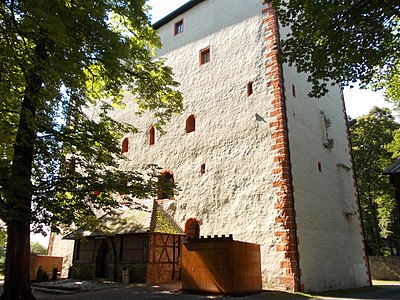Orlamünde bower
The bower Orlamünde is a remnant of a castle from the 11th and 12th centuries in Orlamünde above the Saale valley between Jena and Rudolstadt . Orlamünde is the only Thuringian castle that is shown on the Ebstorf world map from around 1300 .
history
The first mention is found in a parish deed from 1194, which refers to older sources before 1067. The castle was therefore owned by Count Otto I of Weimar .
The bower was the core of the Orlamünde castle complex and is the last remaining building in the defense complex, of which only parts of the circular wall and the gate system have otherwise been preserved. It was one of the most powerful broad residential towers in Thuringia and blocked the entire ridge and thus the main attack side. The huge tower block has small and narrow slits of light and an entrance at a height of 9.5 meters. This strict construction as a fort probably originates from southern Italy and was adopted here. Later in Thuringia more bower was built. The Kemenate Ziegenrück and the Kemenate Reinstädt are similar preserved buildings, also above the Saale.
The lengthy inheritance dispute over the county of Weimar-Orlamünde was won by the great-grandson Hermann of the daughter of Count Otto von Weimar, who was now called Count von Orlamünde. After the destruction of Weimar Castle, Orlamünde Castle became the headquarters. Subsequently, the Counts of Orlamünde-Weimar rose to become the strongest ruling dynasty in Thuringia, which later split into several lines. After an over-indebted sale in 1344, there were countless changes of ownership. The castle fell into disrepair and became a quarry for the population, so that only the bower was left as the only utility building.
With the end of the Middle Ages and the rise of the bourgeoisie, the remaining bower was renovated by the city of Orlamünde . It was then used as a granary and warehouse. In the 20th century it began to be used as an advertising medium and for recreational activities: in the 1920s it was also used as a theater backdrop for legendary performances on the wall along the main entrance, which could even be reached by special trains from Leipzig ; an open-air cinema was set up in the 1960s.
The bower is once again used extensively as an event location and club building for the local castle association, and a small local history museum has been set up. Access is possible from time to time.
Web links
Individual evidence
- ↑ castle Orlamünde on burgeninventar.de ( Memento of 25 October 2007 at the Internet Archive )
- ↑ A Sicilian example of a wide residential tower would be the Norman fort of Paternò from 1072.
- ↑ Werner Mägdefrau , Rainer Lämmerhirt , Dana Lämmerhirt: Thuringian castles and fortifications in the Middle Ages. A trip to the Middle Ages. Rockstuhl, Bad Langensalza 2001, ISBN 3-934748-43-0 , pp. 33, 95-97.
- ↑ Angelika Schimmel: "Films to laugh and reflect under the stars" , OTZ, June 26, 2019
Coordinates: 50 ° 46 ′ 37 ″ N , 11 ° 31 ′ 41 ″ E



